Page 2 of 564
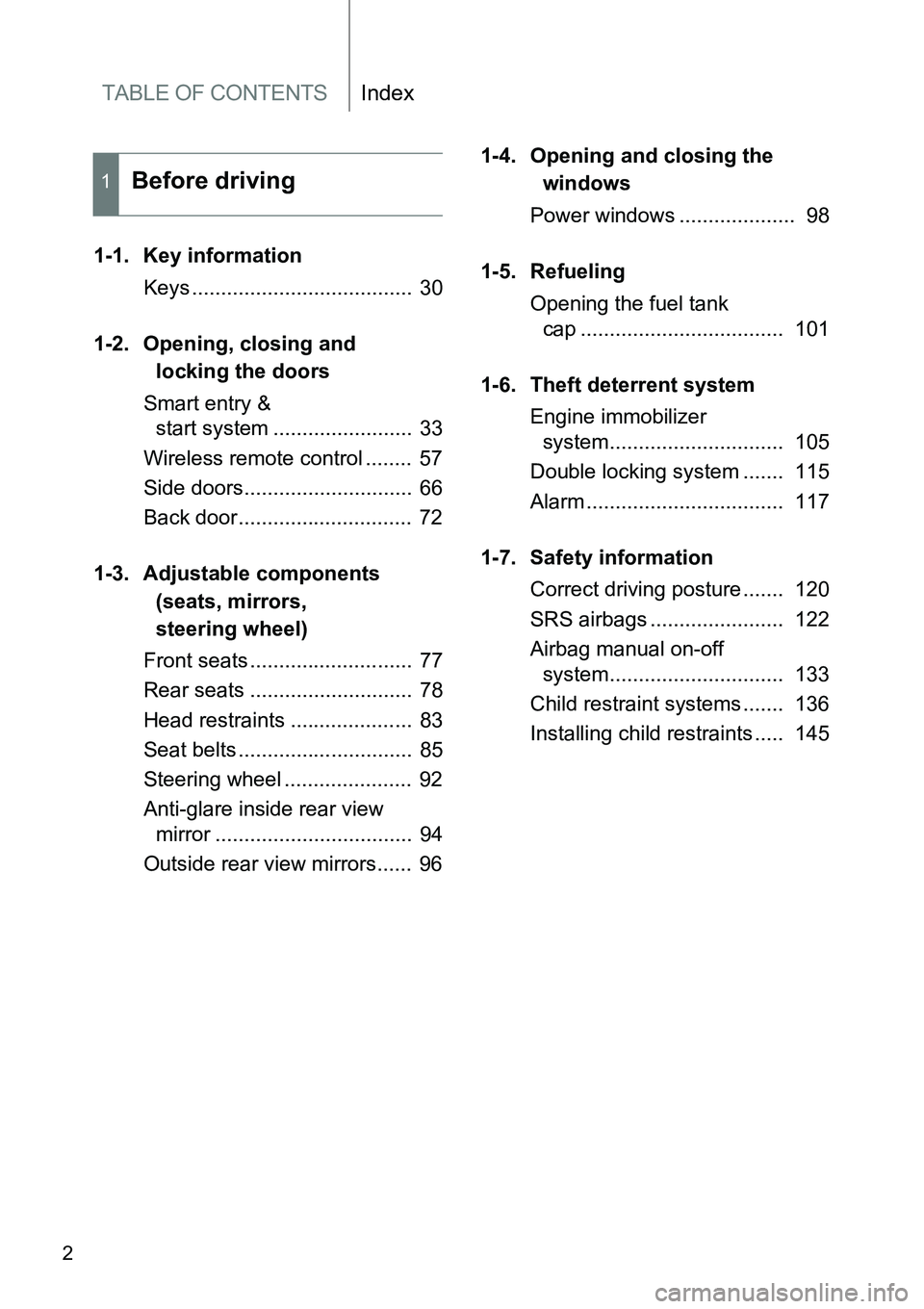
TABLE OF CONTENTSIndex
2
1-1. Key information
Keys ...................................... 30
1-2. Opening, closing and
locking the doors
Smart entry &
start system ........................ 33
Wireless remote control ........ 57
Side doors............................. 66
Back door.............................. 72
1-3. Adjustable components
(seats, mirrors,
steering wheel)
Front seats ............................ 77
Rear seats ............................ 78
Head restraints ..................... 83
Seat belts .............................. 85
Steering wheel ...................... 92
Anti-glare inside rear view
mirror .................................. 94
Outside rear view mirrors...... 961-4. Opening and closing the
windows
Power windows .................... 98
1-5. Refueling
Opening the fuel tank
cap ................................... 101
1-6. Theft deterrent system
Engine immobilizer
system.............................. 105
Double locking system ....... 115
Alarm .................................. 117
1-7. Safety information
Correct driving posture ....... 120
SRS airbags ....................... 122
Airbag manual on-off
system.............................. 133
Child restraint systems ....... 136
Installing child restraints ..... 145
1Before driving
Page 5 of 564
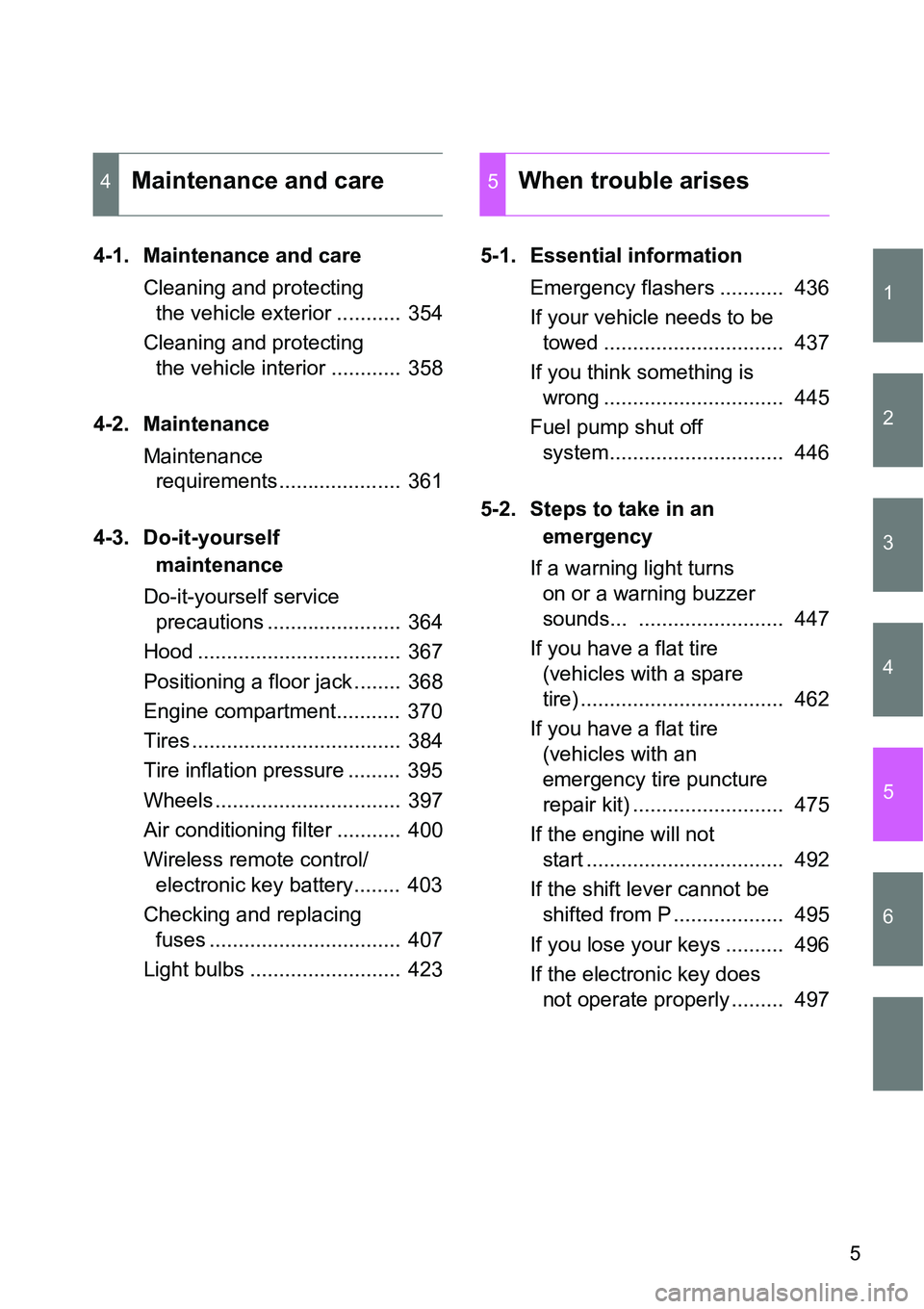
1
2
3
4
5
6
5
4-1. Maintenance and care
Cleaning and protecting
the vehicle exterior ........... 354
Cleaning and protecting
the vehicle interior ............ 358
4-2. Maintenance
Maintenance
requirements..................... 361
4-3. Do-it-yourself
maintenance
Do-it-yourself service
precautions ....................... 364
Hood ................................... 367
Positioning a floor jack ........ 368
Engine compartment........... 370
Tires .................................... 384
Tire inflation pressure ......... 395
Wheels ................................ 397
Air conditioning filter ........... 400
Wireless remote control/
electronic key battery........ 403
Checking and replacing
fuses ................................. 407
Light bulbs .......................... 4235-1. Essential information
Emergency flashers ........... 436
If your vehicle needs to be
towed ............................... 437
If you think something is
wrong ............................... 445
Fuel pump shut off
system.............................. 446
5-2. Steps to take in an
emergency
If a warning light turns
on or a warning buzzer
sounds... ......................... 447
If you have a flat tire
(vehicles with a spare
tire) ................................... 462
If you have a flat tire
(vehicles with an
emergency tire puncture
repair kit) .......................... 475
If the engine will not
start .................................. 492
If the shift lever cannot be
shifted from P ................... 495
If you lose your keys .......... 496
If the electronic key does
not operate properly ......... 497
4Maintenance and care5When trouble arises
Page 26 of 564
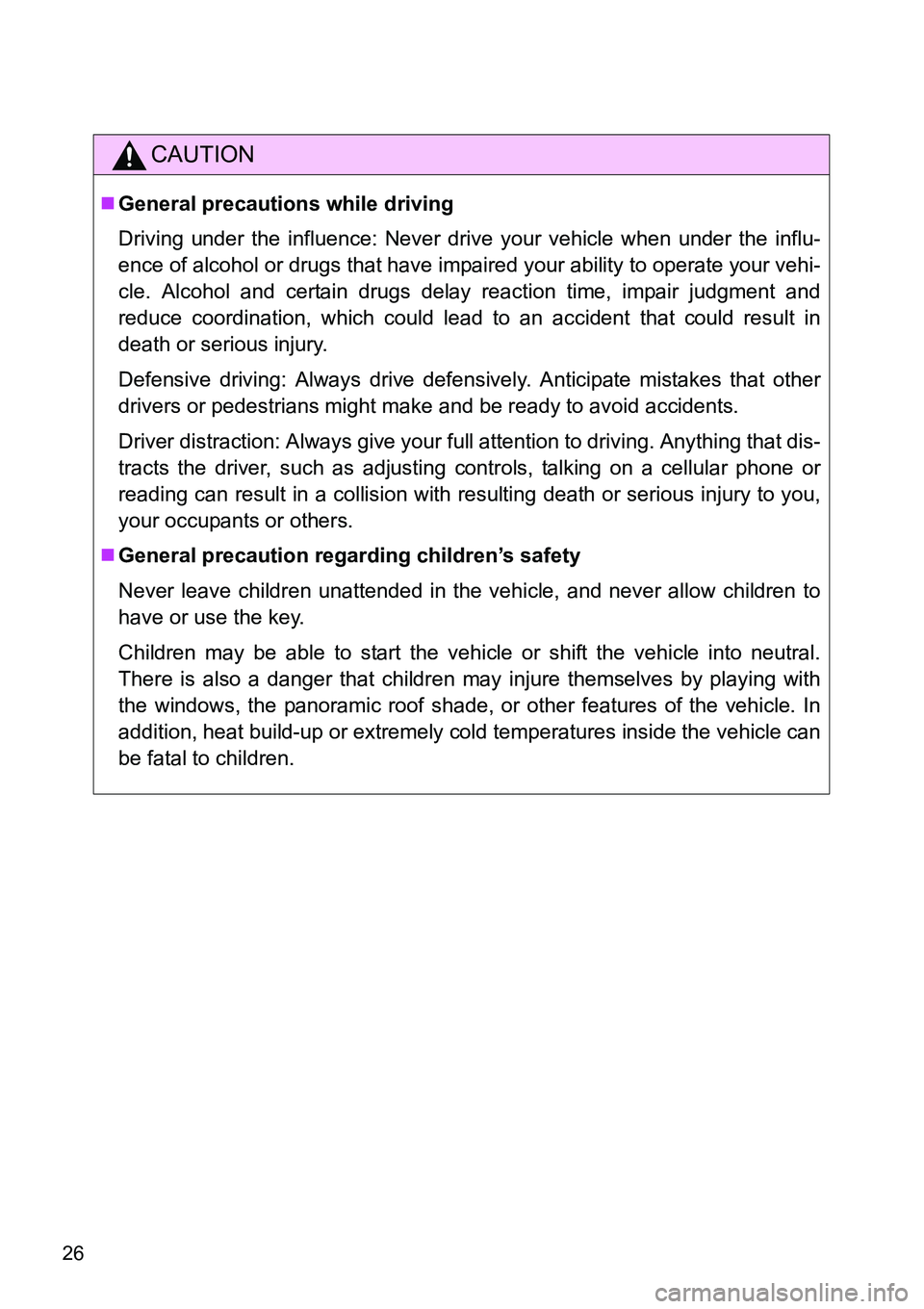
26
CAUTION
General precautions while driving
Driving under the influence: Never drive your vehicle when under the influ-
ence of alcohol or drugs that have impaired your ability to operate your vehi-
cle. Alcohol and certain drugs delay reaction time, impair judgment and
reduce coordination, which could lead to an accident that could result in
death or serious injury.
Defensive driving: Always drive defensively. Anticipate mistakes that other
drivers or pedestrians might make and be ready to avoid accidents.
Driver distraction: Always give your full attention to driving. Anything that dis-
tracts the driver, such as adjusting controls, talking on a cellular phone or
reading can result in a collision with resulting death or serious injury to you,
your occupants or others.
General precaution regarding children’s safety
Never leave children unattended in the vehicle, and never allow children to
have or use the key.
Children may be able to start the vehicle or shift the vehicle into neutral.
There is also a danger that children may injure themselves by playing with
the windows, the panoramic roof shade, or other features of the vehicle. In
addition, heat build-up or extremely cold temperatures inside the vehicle can
be fatal to children.
Page 29 of 564
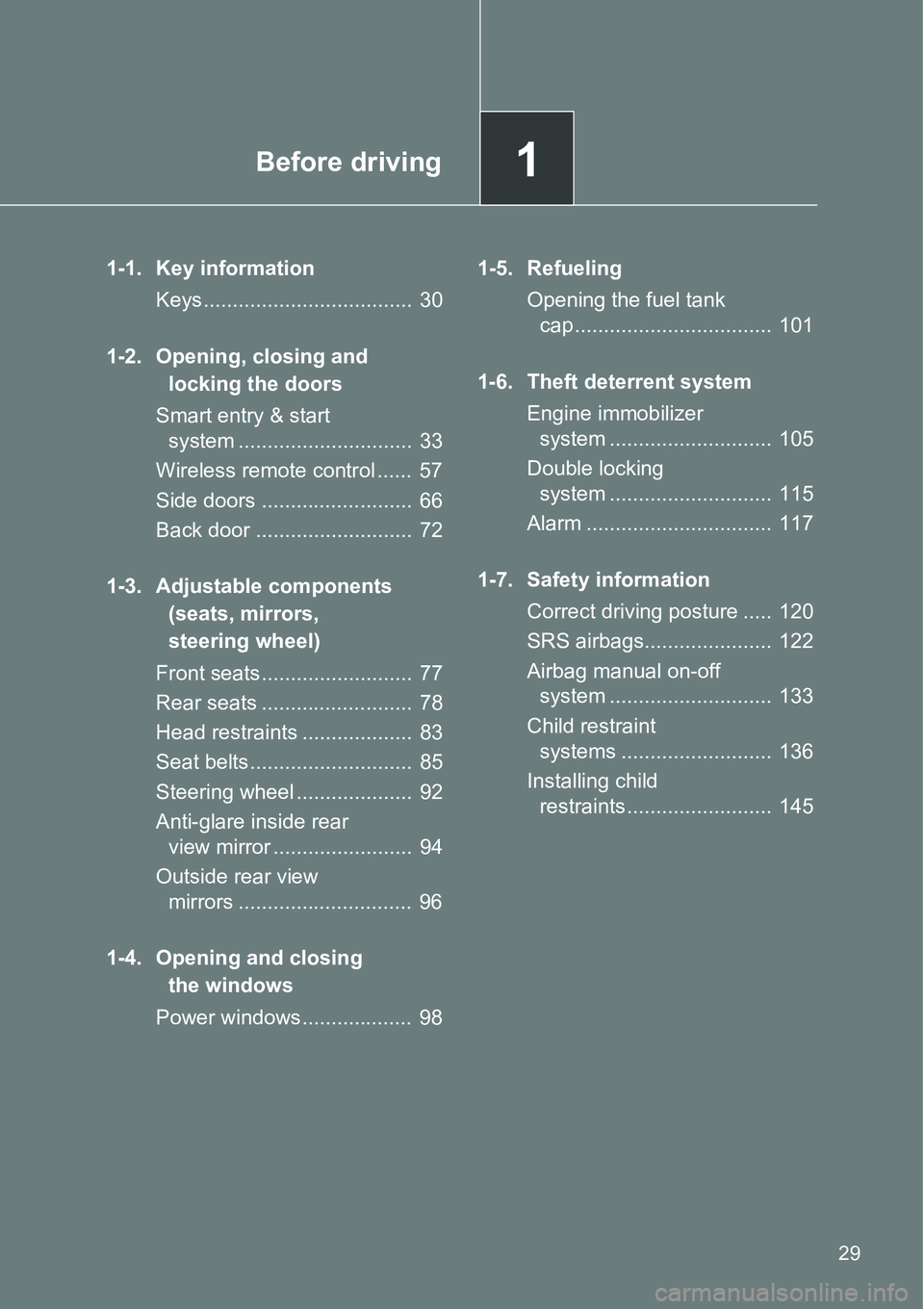
1Before driving
29
1-1. Key information
Keys.................................... 30
1-2. Opening, closing and
locking the doors
Smart entry & start
system .............................. 33
Wireless remote control ...... 57
Side doors .......................... 66
Back door ........................... 72
1-3. Adjustable components
(seats, mirrors,
steering wheel)
Front seats.......................... 77
Rear seats .......................... 78
Head restraints ................... 83
Seat belts............................ 85
Steering wheel .................... 92
Anti-glare inside rear
view mirror ........................ 94
Outside rear view
mirrors .............................. 96
1-4. Opening and closing
the windows
Power windows................... 981-5. Refueling
Opening the fuel tank
cap .................................. 101
1-6. Theft deterrent system
Engine immobilizer
system ............................ 105
Double locking
system ............................ 115
Alarm ................................ 117
1-7. Safety information
Correct driving posture ..... 120
SRS airbags...................... 122
Airbag manual on-off
system ............................ 133
Child restraint
systems .......................... 136
Installing child
restraints ......................... 145
Page 30 of 564
30
1-1. Key information
Keys
The following keys are provided with the vehicle.
Vehicles without a smart entry & start system (type A)
Key (with a wireless remote
control function)
Operating the wireless remote
control function (P. 57)
Key (without a wireless
remote control function)
Key number plate
Vehicles without a smart entry & start system (type B)
Keys
Operating the wireless remote
control function (P. 57)
Key number plate
Vehicles with a smart entry & start system
Electronic keys
• Operating the smart entry &
start system (P. 33)
• Operating the wireless
remote control function
(P. 57)
Mechanical keys
Key number plate
Page 31 of 564
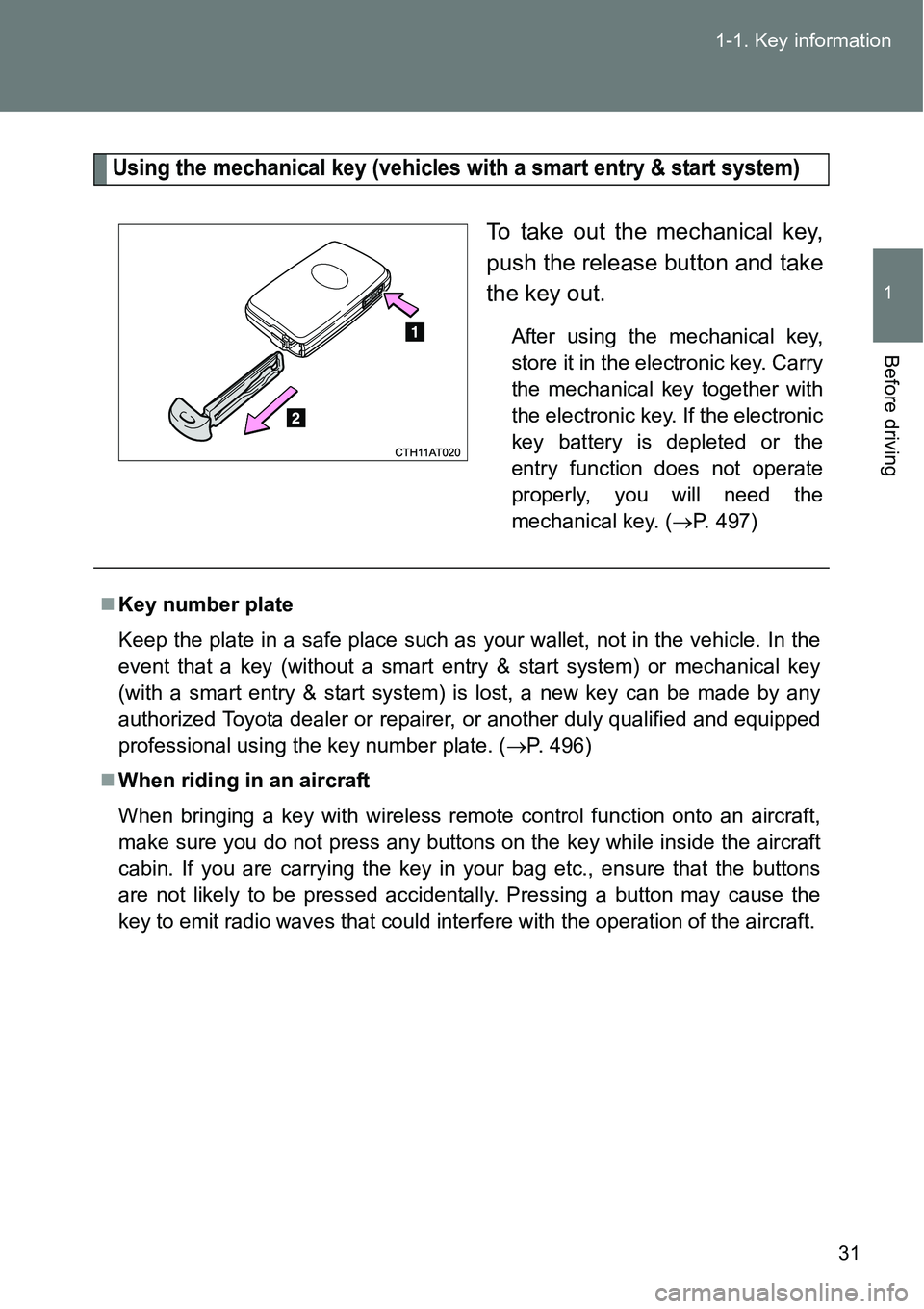
31 1-1. Key information
1
Before driving
Using the mechanical key (vehicles with a smart entry & start system)
To take out the mechanical key,
push the release button and take
the key out.
After using the mechanical key,
store it in the electronic key. Carry
the mechanical key together with
the electronic key. If the electronic
key battery is depleted or the
entry function does not operate
properly, you will need the
mechanical key. (P. 497)
Key number plate
Keep the plate in a safe place such as your wallet, not in the vehicle. In the
event that a key (without a smart entry & start system) or mechanical key
(with a smart entry & start system) is lost, a new key can be made by any
authorized Toyota dealer or repairer, or another duly qualified and equipped
professional using the key number plate. (P. 496)
When riding in an aircraft
When bringing a key with wireless remote control function onto an aircraft,
make sure you do not press any buttons on the key while inside the aircraft
cabin. If you are carrying the key in your bag etc., ensure that the buttons
are not likely to be pressed accidentally. Pressing a button may cause the
key to emit radio waves that could interfere with the operation of the aircraft.
Page 32 of 564
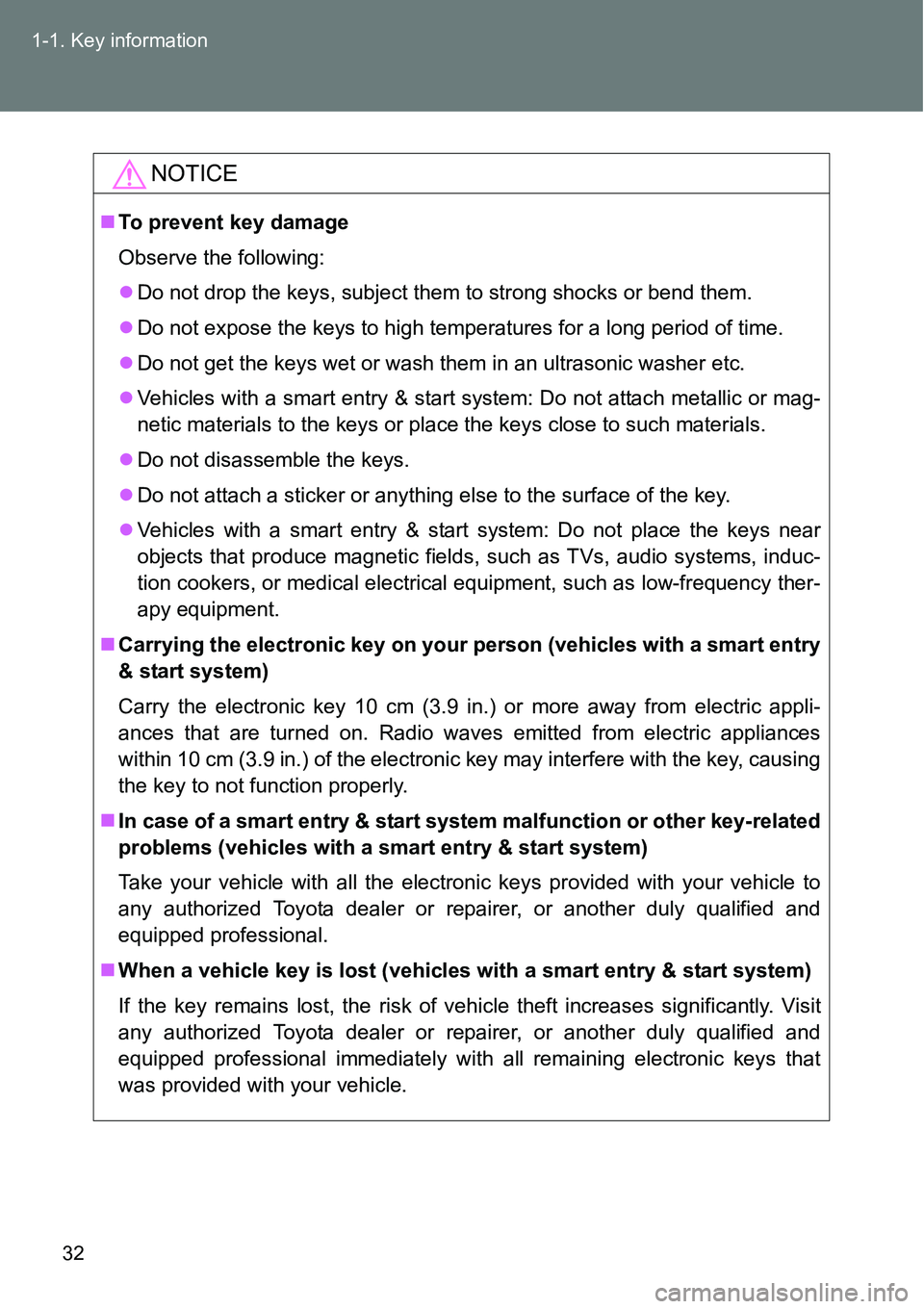
32 1-1. Key information
NOTICE
To prevent key damage
Observe the following:
Do not drop the keys, subject them to strong shocks or bend them.
Do not expose the keys to high temperatures for a long period of time.
Do not get the keys wet or wash them in an ultrasonic washer etc.
Vehicles with a smart entry & start system: Do not attach metallic or mag-
netic materials to the keys or place the keys close to such materials.
Do not disassemble the keys.
Do not attach a sticker or anything else to the surface of the key.
Vehicles with a smart entry & start system: Do not place the keys near
objects that produce magnetic fields, such as TVs, audio systems, induc-
tion cookers, or medical electrical equipment, such as low-frequency ther-
apy equipment.
Carrying the electronic key on your person (vehicles with a smart entry
& start system)
Carry the electronic key 10 cm (3.9 in.) or more away from electric appli-
ances that are turned on. Radio waves emitted from electric appliances
within 10 cm (3.9 in.) of the electronic key may interfere with the key, causing
the key to not function properly.
In case of a smart entry & start system malfunction or other key-related
problems (vehicles with a smart entry & start system)
Take your vehicle with all the electronic keys provided with your vehicle to
any authorized Toyota dealer or repairer, or another duly qualified and
equipped professional.
When a vehicle key is lost (vehicles with a smart entry & start system)
If the key remains lost, the risk of vehicle theft increases significantly. Visit
any authorized Toyota dealer or repairer, or another duly qualified and
equipped professional immediately with all remaining electronic keys that
was provided with your vehicle.
Page 33 of 564
33
1
Before driving
1-2. Opening, closing and locking the doors
Smart entr y & start system
: If equipped
The following operations can be performed simply by carrying the
electronic key on your person, for example in your pocket.
(The driver should always carry the electronic key.)
Unlocks and locks the side doors (P. 3 4 )
Unlocks and locks the back door (P. 35)
Starts the engine (P. 173)
Electronic key
Electronic key
Electronic key